The Full Intel SSD 525 Review: 30GB, 60GB, 120GB, 180GB & 240GB Tested
by Anand Lal Shimpi on February 3, 2013 2:30 AM EST- Posted in
- Storage
- SSDs
- Intel
- SandForce
- Intel SSD 520
- Intel SSD 525
AnandTech Storage Bench 2011 - Light Workload
Our new light workload actually has more write operations than read operations. The split is as follows: 372,630 reads and 459,709 writes. The relatively close read/write ratio does better mimic a typical light workload (although even lighter workloads would be far more read centric).
The I/O breakdown is similar to the heavy workload at small IOs, however you'll notice that there are far fewer large IO transfers:
| AnandTech Storage Bench 2011 - Light Workload IO Breakdown | ||||
| IO Size | % of Total | |||
| 4KB | 27% | |||
| 16KB | 8% | |||
| 32KB | 6% | |||
| 64KB | 5% | |||
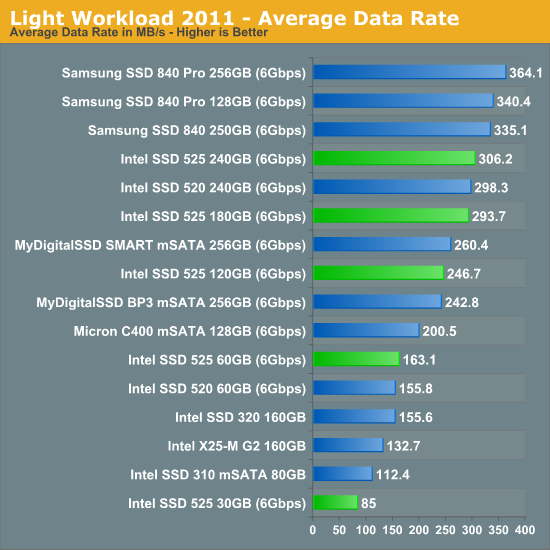
The 525s do a bit better vs. the competition in our light workload, but the gap between capacities doesn't change all that much.
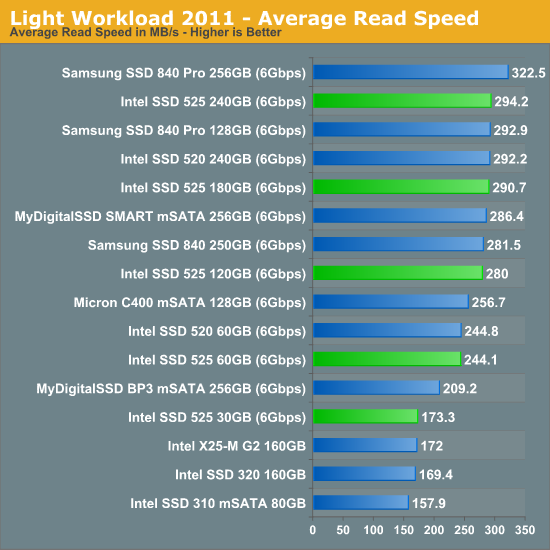
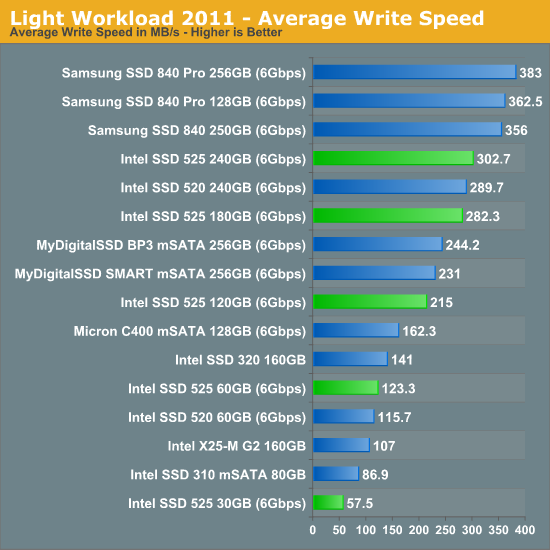
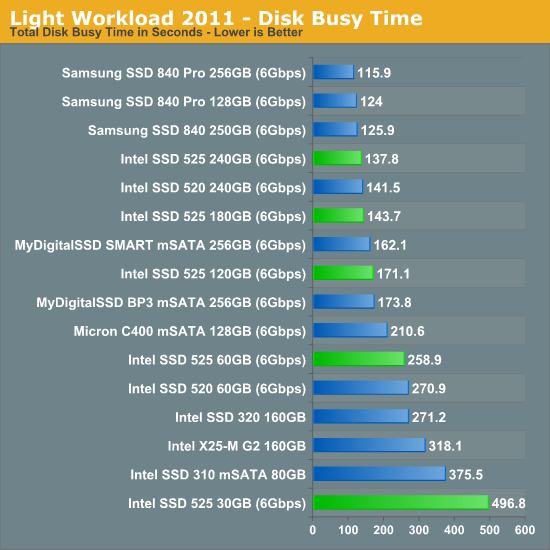
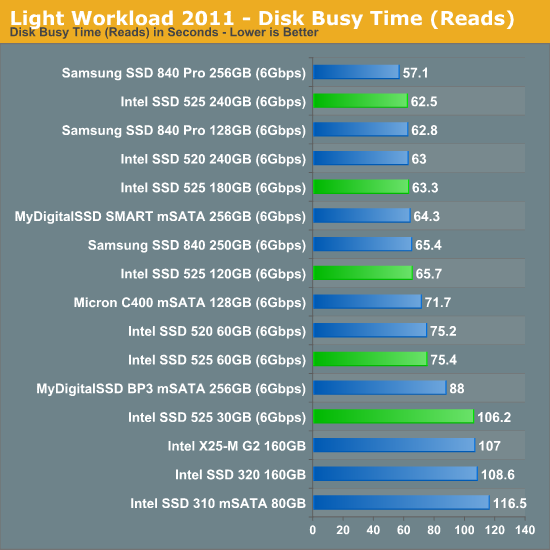
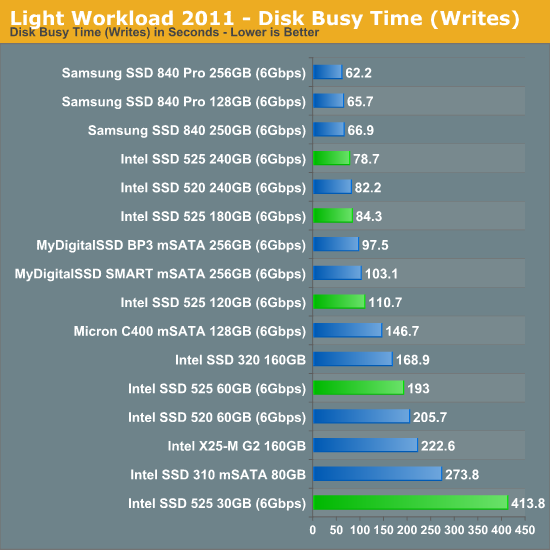










26 Comments
View All Comments
PolarisOrbit - Monday, February 4, 2013 - link
The comparison table on the first page indicates a 90GB drive and then it's never mentioned again in the rest of the article.Denithor - Monday, February 4, 2013 - link
Addressed in the first paragraph:"At the time we only presented performance for a single 240GB drive, however Intel decided to break the mold and send us nearly every capacity in the 525 lineup."
I would imagine that the 90GB model is the one they didn't provide.
AndrewDobie - Monday, February 4, 2013 - link
Love my job, since I've been bringing in $5600… I sit at home, music playing while I work in front of my new iMac that I got now that I'm making it online.(Click Home information)http://goo.gl/nY29F
philipma1957 - Monday, February 4, 2013 - link
first what mobo can I buy that will run at sata III speeds.I have 3 mobos with msata's all 3 use sata II speed's.
I have an intel h77 itx
an asrock z77 itx
an asus z77 matx
second question when will the crucial m500 480gb drop?
third question which has nothing to do with msata just sata. when does sata IV come out.
I get a bit bored with ssd reviews since speed is pretty much capped at 550 read write.
iops are not going to go to 550 read write at random 4k.
so sata 4 would mean all new speeds to droll over.
a bigger msata like the crucial m500 would be nice.
and an itx board that used msata at sata III would be nice.
not knocking intel but ssd's seem to have become more of the same.
As Jimmy Fallon would say bigger harder faster stronger.
oh one last thing the 5 year warranty is nice.
Kristian Vättö - Monday, February 4, 2013 - link
Crucial M500 is Q2'13, that's all we know for now. I'm very interested in the drive as well, hopefully we can get samples soon.SATA Express is the future of SATA, we likely won't see SATA IV (12Gbps) for a few years (if we'll ever even see it). We may see some SATAe based SSDs/mobos H2'13 but I haven't heard any specific time frame.
DanNeely - Monday, February 4, 2013 - link
That's disappointing; I was hoping they'd be available by 13Q2 to go along with the Haswell launch since there will be an uptick of enthusiast system building then. Based on prior history my Haswell box will last at least until Skylake launches; and probably until the tick following it four years from now.ssj3gohan - Monday, February 4, 2013 - link
... because I just care that much :DBut seriously, Anandtech. Let's talk logic here. Intel has specification sheets with detailed power consumption numbers. It says for the entire SSD 525 series: 250mW idle typical, 300mW under mobilemark 2007.
How can you look at your own power consumption numbers and say 'well, close enough, let's just publish it even though it's 100% too high and clearly not correct'?
Here's how to fix your SSD power consumption errors: measure power consumption going directly into the drive on all rails and use it in a system that has device initiated power management features enabled (DIPM), that is: basically all operating systems nowadays.
Anand Lal Shimpi - Monday, February 4, 2013 - link
As I mentioned in the review, the mSATA adapter we test with only supplies 5V to the drive. To address this going forward I need to modify a board with a native mSATA connector and measure 3.3V on the board itself. The results here at least allow you to compare the various capacities of the 525.MobileMark 2007 is mostly an idle test, which is why none of our loaded numbers have ever come close to any spec sheet that reports it. This is the same reason we don't use it in our notebook reviews.
We will be switching to DIPM-only testing in our 2013 storage suite update, which will unfortunately break backwards comparability with our older results.
Take care,
Anand
RU482 - Monday, February 4, 2013 - link
Anand,What mSATA adapter board are you using?
Just a thought, you should be able to lift a lead on the 5-to-3.3V regulator on the board and measure the output current with a multi-meter.
extide - Monday, February 4, 2013 - link
Also note that those mSATA to SATA converters use a little linear regulator(like a 7833) to convert the 5v to 3.3v. Linear regulators are very in-efficient, as they essentially turn the "extra" voltage into heat by using a network of resistors.If you are simply measuring the power into the adapter then you are not getting a very good look at the actually mSATA device power draw.
HOWEVER, if someone else is using the adapter in their system they will also be utilizing that same linear regulator, and thus see the same power usage as they show in the article here.